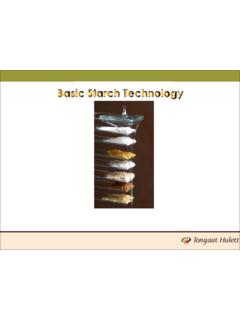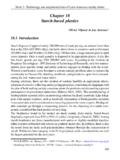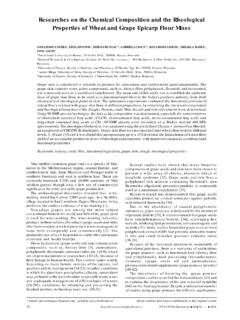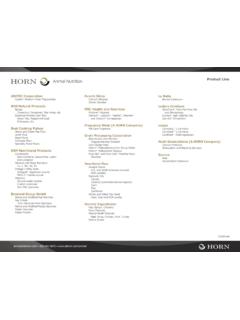Transcription of Physicochemical properties, modifications and applications ...
1 Food Sci. Technol, Campinas, 35(2): 215-236, 2015215 Food Science and TechnologyISSN 0101-2061DI: StarchStarch is the most abundant carbohydrate reserve in plants and is found in leaves, flowers, fruits, seeds, different types of stems and roots. starch is used by plants as source of carbon and energy (Smith, 2001). The biochemical chain responsible for starch synthesis involves glucose molecules produced in plant cells by photosynthesis. starch is formed in the chloroplasts of green leaves and amyloplasts, organelles responsible for the starch reserve synthesis of cereals and tubers (Smith, 2001; Tester et al., 2004). starch production in the chloroplast is diurnal and performed rapidly by the plant. Conversely, starch reserves produced by amyloplasts are deposited over several days, or even weeks. starch is stored and cyclically mobilized during seed germination, fruit maturation and the sprouting of tubers (Ellis et al.)
2 , 1998). The main location of starch synthesis and storage in cereals is the endosperm. Major starch sources are cereals (40 to 90%), roots (30 to 70%), tubers (65 to 85%), legumes (25 to 50%) and some immature fruits like bananas or mangos, which contain approximately 70% of starch by dry weight (Santana & Meireles, 2014). The accumulation pattern of starch granules in each plant tissue, shape, size, structure and composition is unique to each botanical species (Smith, 2001). starch synthesized by plant cells is formed by two types of polymers: amylopectin and amylose. Amylopectin consists of linear chains of glucose units linked by -1,4 glycosidic bonds and is highly branched at the -1,6 positions by small glucose chains at intervals of 10 nm along the molecule s axis; it constitutes between 70 to 85% of common starch (Durrani & Donald, 1995). Amylose is essentially a linear chain of -1,4 glucans with limited branching points at the -1,6 positions and constitutes between 15-30% of common starch .
3 starch s structural units, amylose and amylopectin, are shown in Figure 1. The polymodal distribution of -glucans chains of different sizes and the grouping of branch points in the amylopectin molecule allow the formation of double helical chains. Amylose and amylopectin can be arranged in a semicrystalline structure forming a matrix of starch granules with alternating amorphous (amylose) and crystalline (amylopectin) material, which is known as the growth rings in superior plant starch (Jenkins et al., 1993).Several types of starches are known as waxy starches due to the waxy appearance of the endosperm tissue from which they are derived; these tissues contain a minimal amount of amylose in their granule composition (<15%). Waxy starch requires high energy for gelatinization due to its high crystallinity (Hung et al., 2007). Dther starches have a high content of amylose (>30%); these starches can also contain other polysaccharide molecules and exhibit a slight deformation in granule starches contain lipid molecules in their structures in the form of phospholipids and free fatty acids; they are associated with the amylose fraction (Ellis et al.)
4 , 1998; Tester et al., 2004). The presence of lipid complexes in starch granules is observed as a hydrophobic nucleus situated within helices formed by amylose chains. The lipid complexes vary between to of the amylose fraction in cereal starches (Tester et al., 2004). Lipids in starch granules, despite representing a small fraction, can significantly reduce the swelling capacity of the starch paste (Morrison & Azudin, 1987). starch contains approximately of protein associated with the molecule. The origins of protein and lipids on starch are situated on the granule surface. Lipids and proteins in starch granules can raise its functionality. In wheat for example, the associated protein in the starch granules receives a lot attention due to its association with grain Physicochemical properties, modifications and applications of starches from different botanical sourcesSylvia Carolina ALC ZAR-ALAY1, Maria Angela Almeida MEIRELES1*aReceived 22 May, 2015 Accepted 25 May, 20151 Faculdade de Engenharia de Alimentos FEA, Universidade Estadual de Campinas UNICAMP, Campinas, SP, Brazil*Corresponding author: trends towards technologies and processes that increase the use of residues make starchy vegetal biomass an important alternative material in various applications due to starch s versatility, low cost and ease of use when its Physicochemical properties are altered.
5 starch is increasingly used in many industrial applications and as a renewable energy resource. starch can be modified to enhance its positive attributes and eliminate deficiencies in its native characteristics. In this article, the state of knowledge on conventional and unconventional starches and their properties, characteristics, modifications and applications are : starch modification; starch granules; paste properties; conventional starch ; unconventional starch ; starch biomass; Application: Use of unconventional starches and vegetal residues containing starch in of starches from different sourcesFood Sci. Technol, Campinas, 35(2): 215-236, 2015216hardness. starch also contains a relatively small quantity (< ) of minerals (calcium, magnesium, phosphorus, potassium and sodium). Among these, phosphorus is of primary importance and is present in starch in three main forms: monophosphate esters, phospholipids and inorganic physical and chemical aspects of starch synthesis and the composition of amylose and amylopectin have been discussed in detail in other reviews by Smith (2001), Tester et al.
6 (2004), P rez & Bertoft (2010) and Conde-Petit et al. (2001).2 Physicochemical properties of starchThe length of the -glucan chains, amylose-amylopectin ratio and branching degree of amylopectin define the size, structure and particular utility of starch granules in each plant species. Dther characteristics associated with the granule such as form, surface type and phosphate groups influence the starch s properties and uses (Smith, 2001). Characteristics of starch granules: morphology, size, composition and crystallinityStarch granules have microscopic sizes with diameters ranging from to 200 m, and its morphology varies between different shapes, such as oval, ellipsoidal, spherical, smooth, angular and lenticular, depending on the botanical source (Bul on et al., 1998; Hoover, 2001; Singh et al., 2003). Size distribution can be uni-, bi-, or polymodal. In amyloplasts, starch granules are present individually or in groups (Jane et al., 1994; P rez & Bertoft, 2010).
7 Common cereals such as wheat, barley and rye contain two types of starch granules: (i) A-type, lenticular shape and large size and (ii) B-type, spherical shape and small size (Tester et al., 2006; Vamadevan & Bertoft, 2015). The Physicochemical properties of certain native starches are listed in Table 1. starch granules are typically isolated before microscopic observation, and the isolation method is important because it can potentially affect the starch s original size (Gao et al., 2014; Lawal et al., 2011). Granule morphology typically contains a central line known as the hilum or Maltese cross . Each starch granule may contain one or more Maltese crosses, and this characteristic reduces the birefringence ability of the starch granule (Jiang et al., 2010).The amount of amylose present in the granule significantly affects the Physicochemical and functional properties of starch . The amylose content can vary within the same botanical variety because of differences in geographic origin and culture conditions (Gao et al.)
8 , 2014). Researchers have highlighted the role of amylose in the initial resistance of granules to swelling and solubility, as swelling proceeds rapidly after leaching of amylose molecules. The capacity of amylose molecules of form lipid complexes prevents their leaching and consequently the swelling capacity (Singh et al., 2003). Amylose is anhydrous and can form excellent films, which are important characteristics for industrial applications . Films formed by amylose are very strong, colorless, odorless and tasteless (Campos et al., 2011).Phosphorus is one of the non-carbohydrate components present in the starch granule and significantly affects its functional characteristics. Phosphorus is present as monoester phosphates or phospholipids in various types of starches. Monoester phosphates are associated with the amylopectin fraction by covalent bonds, increasing the clarity and viscosity of the paste, whereas the presence of phospholipids results in opaque and low viscosity pastes (Craig et al.
9 , 1989). The phospholipid content in starch granules is proportionally related to amylose. Phospholipids tend to form complexes with amylose and long branches of amylopectin, resulting in starch granules with limited solubility (Morrison et al., 1993; Singh et al., 2003). The nature of the phosphorus in starch granules has an important influence on the transmittance of the paste. Starches such as wheat and rice with high phospholipid contents produce pastes with low transmittance power compared to potato or corn starch pastes because the latter starches contain less phospholipids. Potato starch demonstrates high transmittance due to its phosphate monoester content (Singh et al., 2003).Figure 1. Basic structural design of (a) glucose units, (b) amylose and (c) amylopectin, along with the labeling of the atoms and torsion angles. Extension of the basic units to macromolecular structures was adapted from P rez & Bertoft (2010).Alc zar-Alay; MeirelesFood Sci.
10 Technol, Campinas, 35(2): 215-236, 2015217Ta b l e 1. Morphology and composition of native starch granules from various ShapeDiameter( m)Lipid (%w/w)Protein (%w/w)Phosphorus (%w/w)Amylose (%w/w)Degree of crystallinity/ Crystalline typeWheatWild typeSpherical and lenticular (Singh et al., 2003)A-type: Spherical or ellipsoidal (Zhang et al., 2013)B-type: Disc-shape and lenticular< 30 (Singh et al., 2003)22-36 (Jane et al., 1994)A-type: >10 (Zhang et al., 2013)B-type: < 10 (Zhang et al., 2013) (Bul on et al., 1998) ( ubari et al., 2012) (Sang et al., 2007) (Hung et al., 2007) (Hung et al., 2007)Waxy0 (Morrison et al., 1984) (Hung et al., 2007) (Hung et al., 2007)High (Hung et al., 2007) (Hung et al., 2007)BarleyWild typeA-type: Disc-shape (Ellis et al., 1998)B-type: lenticular (Ellis et al., 1998)A-type:10-25 (Ellis et al., 1998)B- type: 5 (Ellis et al., 1998) (Morrison et al., 1984) (Ellis et al., 1998) (Ellis et al.)














